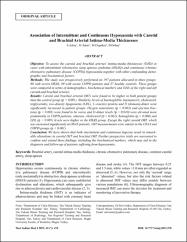Association of Intermittent and Continuous Hypoxaemia with Carotid and Brachial Arterial Intima-Media Thicknesses
Abstract
Objective: To assess the carotid and brachial arteries' intima-media thicknesses (IMTs) in cases with intermittent (obstructive sleep apnoea syndrome (OSAS)) and continuous (chronic obstructive pulmonary disease (COPD)) hypoxaemia together with other confounding demographic and biochemical factors.
Methods: The study was prospectively performed on 197 patients allocated in three groups: 80 with severe OSAS, 80 with severe COPD patients and 37 healthy controls. These groups were compared in terms of demographics, biochemical markers and IMTs of the right and left carotid and brachial arteries.
Results: Carotid and brachial arterial IMTs were found to be higher in both patient groups than the control group (p < 0.001). Similarly, levels of haemoglobin, haematocrit, cholesterol, triglycerides, low-density lipoproteins (LDL), C-reactive protein and D (domain)-dimer were significantly increased in patient groups. Oxygen saturations (p < 0.001) and ejection fractions (p = 0.001) were found to be worse and D-dimer levels (p = 0.010) were elevated more prominently in COPD patients, whereas, cholesterol (p < 0.001), hemoglobin (p = 0.004) and LDL (p = 0.001) levels were higher in the OSAS group. Except the right carotid IMT, which was increased significantly in OSAS patients, IMT measurements were similar in the OSAS and COPD groups (p < 0.001).
Conclusion: We have shown that both intermittent and continuous hypoxia result in remarkable alterations in carotid BIT and brachial IMT. Further prospective trials are warranted to confirm and extend these findings, including the biochemical markers, which may aid in the diagnosis and follow-up of patients suffering from hypoxaemia.


















